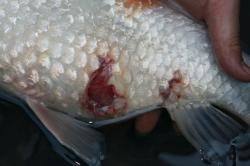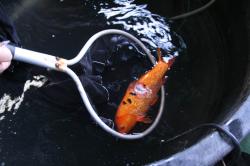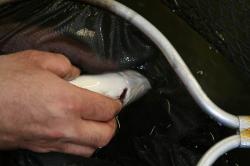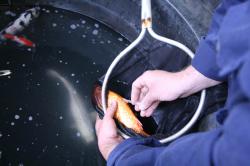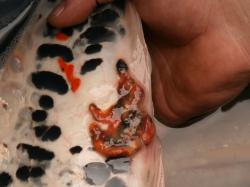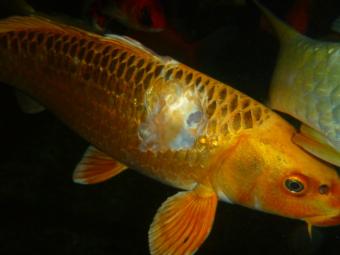- Information
- Products
- Pond Construction
- Koi Info
- Pond Info
- Portfolio
- Portfolio Introduction
- Portfolio I
- Portfolio II
- Portfolio III
- Portfolio IV
- Portfolio V
- Portfolio VI
- Portfolio VII
- Porfolio VIII
- Porfolio IX
- Portfolio X
- Porfolio XI
- Porfolio XII
- Portfolio XIII
- Porfolio XIV
- Portfolio XV
- Portfolio XVI
- Portfolio XVII
- Portfolio XVIII
- Portfolio XIX
- Portfolio XX
- Portfolio XXI
- Interest
koi ulceration
Ulcers are an unfortunate reality in this hobby because bacteria are omnipresent. They can occur frequently if koi husbandry is poor and catalyst parasites like flukes present. Morbidity will likely follow if ulcers are not given prompt attention - particularly with small koi who lack a developed constitution
The Causes of Ulcers
Ulcers are bacterial infections which eat away at the flesh of the fish. In most cases I have worked with, they are precipitated by a parasite infection. Whether it be flukes or protozoa, the slime coat is compromised and the ubiquitous aeromonas/pseudomonas bacteria are able to get a foothold. Sometimes there are no parasites involved and the problem is strictly bacterial. Because we have only identified about 1% of the bacteria in existence, what exactly is affecting our fish may be unknown The larger picture dictates that the root causes need to be rectified if the ulcers are to be healed and not reappearIdentifying Ulcers
Ulcers usually start as small red blemishes that are often missed by the less attentive koi keeper. Many times they are located underneath the koi which makes spotting them at this stage difficult. What appears as a small sore on a fish in the pond is often a large gruesome hole upon closer inspection in a koi bowl. In advanced cases, muscle may be exposed in which case scales do not grow back. The ulcer will continue to worsen if treatments are not administered quickly, and the infection has a change to go systemicA disease state which affects the body as a whole, including tissues and organsFundamental Ulcer Treatments
A common mistake I observe with ulcer treatment is clients utilizing just 1-2 approaches to deal with the problem. For example, clients may feed medicated food and add Koizyme and the rest of the treatment protocol is based on "hope". It is much better to undertake a full course of treatments to give the fish every chance of recovery

Sodium Chloride
Salt is pivotal because ulcers compromise osmoregulation. A gaping sore allows an unabated influx of water to enter the fish which contributes to a bloated swelling appearance [dropsy]. Adding salt reduces the gradient between both the water and the fishes salt concentration so less water is taken in. Salting to 0.3% or more means less water enters the fish which reduces bloating and allows the fish to use its energy to fight the infection instead of expelling water Warm up the Water
Heating to the high 70's low 80's is also advisable. At this temperature, the fishes immune system will be functioning at its peak affording it every opportunity to fight the infectionWater Quality
Of course WQ must be maintained at pristine levels. If a fish has to deal with high ammonia or low oxygen levels, it simply will not respond well to treatments. A seeded filter and a UV sterilizer are essential along with several water changes per weekKill all Pathogens
Of course, eradicating any parasites involved is paramount. Trying to heal a wound that is being actively aggravated will prove futileMedications
As mentioned, when you treat sick fish, it is advisable to do everything possible and not just rely on 1-2 approachesInjections are sometimes the only hope for a fish. Drugs like baytril and amakacin work well. Although injecting is not that difficult, it does take some practice to handle fish without stressing them. Unless you have your own private lab or connections, the results of a culture and sensitivity test will likely come to late - you will simply learn what killed your fish. Luckily these antibiotics are broad spectrum and if you choose correctly you may see a small ulcer heal over in just a weeks time
Tricide Neo is usually a successful bactericidal dip. Exercise caution with small fish that seem to do better with dips in the 3 minute range rather than the full 5 minute maximum. If you can't perform injections, you should be doing these dips. The drug is mixed in distilled water and will retain its chemical makeup for 1 week [longer is refrigerated]. You should dip the fish at least 4 times to a maximum of everyday. Use a timer and dip the fish in another bowl of pond water to wash the treatment off before returning the fish to the pond
Medicated Food It is highly advisable to feed the fish a good medicated food for at least 2 weeks. During this time they should feed exclusively on this food and we like to feed small quantities several times a day thereby keeping the antibiotic active in their system. This is a good treatment because it gets right into the fish to treat systemically
Topicals are applied to sterilize and seal the wound to aid in healing. After the initial thorough scrubbing and cleaning of the wound, these should be applied gently so that not to disturb any invisible cells that are trying to grow back as the healing process is underway. We usually try to treat topically a couple of times a week. We use and retail both debride and povodine-iodine ointments
Bifuran is a gram negative bactericide which is broad spectrum and targets pathogenic bacteria only. Therefore, unlike potassium permanganate, it will not harm your bio filter
Koizyme is an effective probioticLive microorganisms which provide a health benefit to the system and or host which introduces a harmless bacteria into the system. This bacteria out competes aeromonas causing a drastic reduction in the pathogenic population. As result, ulcers are less apt to appear and if they do, the development will be retarded. Obviously, the use of bifuran and melafix can interfere with koizyme so use common sense
Melafix is a natural product which has shown great success in healing wounds and regenerating fins. Like Koizyme, it is an excellent ancillary treatment you start after your main drug courses have been undertaken
Koizyme is an effective probioticLive microorganisms which provide a health benefit to the system and or host which introduces a harmless bacteria into the system. This bacteria out competes aeromonas causing a drastic reduction in the pathogenic population. As result, ulcers are less apt to appear and if they do, the development will be retarded. Obviously, the use of bifuran and melafix can interfere with koizyme so use common sense
Melafix is a natural product which has shown great success in healing wounds and regenerating fins. Like Koizyme, it is an excellent ancillary treatment you start after your main drug courses have been undertaken
layers of defense
Koi have several layers of defence. The first is there cuticle or slime coat. It contains goblet cells that release antibodies. Next is a layer of skin [epidermis]. Any sign of ulceration will minimally affect the skin
Next is the dermis that contains the scales. Unfortunately damage here can result in scales not growing back which means noticeable scarring. Below these layers we have the hypodermis and then muscle. Bad ulcers can easily penetrate to the muscle at which time serious bloating [dropsy] will likely occur
Koi have several layers of defence. The first is there cuticle or slime coat. It contains goblet cells that release antibodies. Next is a layer of skin [epidermis]. Any sign of ulceration will minimally affect the skin
Next is the dermis that contains the scales. Unfortunately damage here can result in scales not growing back which means noticeable scarring. Below these layers we have the hypodermis and then muscle. Bad ulcers can easily penetrate to the muscle at which time serious bloating [dropsy] will likely occur

